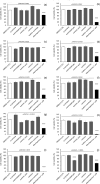Assessment of in vitro and in silico Antiproliferative Effects of p-Cymene and Its Naturally Occurring 7-Oxygenated Derivatives on Human Cancer Cell Lines
- PMID: 39471017
- PMCID: PMC11711345
- DOI: 10.31557/APJCP.2024.25.10.3515
Assessment of in vitro and in silico Antiproliferative Effects of p-Cymene and Its Naturally Occurring 7-Oxygenated Derivatives on Human Cancer Cell Lines
Abstract
Objective: To evaluate the in vitro and silico antiproliferation of p-cymene, cumin aldehyde, cuminic acid, and cuminol against human cancer cell lines (HCCLs). The sodium salt of the organic acid was included after synthesis.
Methods: The quality of the compounds was verified using analytical methods. A primary screening of the compounds at 100 µM was conducted (n=6) on nine HCCLs (SK-MEL-28, K562, Lucena, Jurkat, Caco-2, MDA-MB-231, THP-1, U87-MG, and Calu-3) and HEK-293 through the MTT method after 48h-incubation. The viability curve and apoptotic and necrotic cell populations of cumin aldehyde-treated Calu-3 cells were determined. The statistical significance relative to the vehicle was evaluated using ANOVA and Dunnett. The possibility of being active (Pa) on HCCLs and biological targets was assessed in silico using CLC-Pred. Moreover, the ADMET properties were predicted using three servers.
Results: Only cumin aldehyde induced a low and significant (31±5%, p<0.001) in vitro antiproliferation, and even then, only on the Calu-3 line (IC50 650 µM). Only necrosis was significant (p<0.01) with 300 µM after 24h. The absence (p>0.05) of in vitro activity on the other HCCLs corroborated the low in silico probability of being active (Pa≤0.33), except for cumin aldehyde on the MDA-MB-231 line (Pa=0.47). P-cymene was proven to be the most toxic compound to human health.
Conclusion: Excepting cumin aldehyde, the lack of the antiproliferation potential of these p-cymene derivatives was extensively demonstrated for the first time. Cuminaldehyde induced toxicity in a lung adenocarcinoma line, corroborating the literature. Six selective and three specific cell lines were proposed to evaluate the anticancer activity of the compounds in addressed studies, mainly involving those with Pa≥0.50. The inhibition of five targets seems to play a role in inducing HCCL antiproliferation. The ADMET estimated that cumin aldehyde, cuminol, and sodium cuminate are the safest compounds for human use.
Keywords: ADMET; Antiproliferation; cancer cells; cumin seeds; p-menthane.
Conflict of interest statement
There are no competing interests related to the study.
Figures




Similar articles
-
Chemical Characterization, In-silico Evaluation, and Molecular Docking Analysis of Antiproliferative Compounds Isolated from the Bark of Anthocephalus cadamba Miq.Anticancer Agents Med Chem. 2022;22(20):3416-3437. doi: 10.2174/1871520622666220204123348. Anticancer Agents Med Chem. 2022. PMID: 35125087
-
Anticancer Activity and In Silico ADMET Properties of 2,4,5-Trisubstitutedthiazole Derivatives.Curr Drug Metab. 2021;22(7):532-536. doi: 10.2174/1389200221666201217094602. Curr Drug Metab. 2021. PMID: 33334285
-
Synthesis and characterization of novel combretastatin analogues of 1,1-diaryl vinyl sulfones, with antiproliferative potential via in-silico and in-vitro studies.Sci Rep. 2022 Feb 3;12(1):1901. doi: 10.1038/s41598-022-05958-6. Sci Rep. 2022. PMID: 35115623 Free PMC article.
-
Health beneficial and pharmacological properties of p-cymene.Food Chem Toxicol. 2021 Jul;153:112259. doi: 10.1016/j.fct.2021.112259. Epub 2021 May 11. Food Chem Toxicol. 2021. PMID: 33984423 Review.
-
Targeting the interplay between MMP-2, CA II and VEGFR-2 via new sulfonamide-tethered isomeric triazole hybrids; Microwave-assisted synthesis, computational studies and evaluation.Bioorg Chem. 2022 Jul;124:105816. doi: 10.1016/j.bioorg.2022.105816. Epub 2022 Apr 16. Bioorg Chem. 2022. PMID: 35489270 Review.
Cited by
-
Thymus serpyllum extract exerts anticancer activities against colorectal cancer by modulating metastasis, cell cycle arrest, and apoptosis.Mol Biol Rep. 2025 Jul 18;52(1):732. doi: 10.1007/s11033-025-10838-z. Mol Biol Rep. 2025. PMID: 40679559
References
-
- Ferraz RPC, Bomfim DS, Carvalho NC, Soares MBP, Silva TB, Machado WJ, et al. Cytotoxic effect of leaf essential oil of Lippia gracilis Schauer (Verbenaceae) Phytomed. 2013;20(7):615–21. - PubMed
-
- Fitsiou E, Anestopoulos I, Chlichlia K, Galanis A, Kourkoutas I, Panayiotidis MI, et al. Antioxidant and antiproliferative properties of the essential oils of Satureja thymbra and Satureja parnassica and their major constituents. Anticancer Res. 2016;36(11):5757–63. - PubMed
-
- Li J, Liu C, Sato T. Novel antitumor invasive actions of p-cymene by decreasing MMP-9/TIMP-1 expression ratio in human fibrosarcoma HT-1080 cells. Biol Pharm Bull. 2016;39(8):1247–53. - PubMed
-
- Bourgou S, Pichette A, Marzouk B, Legault J. Bioactivities of black cumin essential oil and its main terpenes from Tunisia. S Afr J Botany. 2010;76(2):210–6.
MeSH terms
Substances
LinkOut - more resources
Full Text Sources
Miscellaneous

